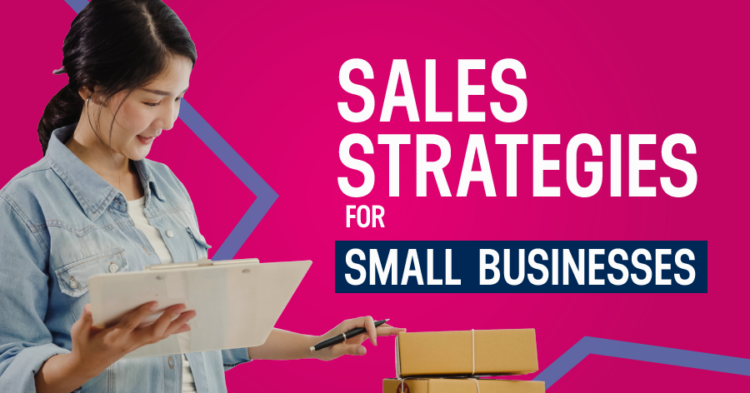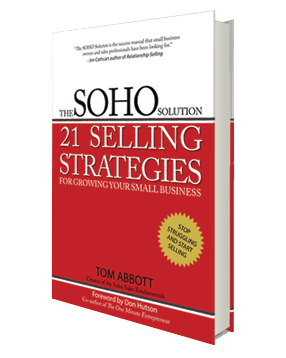
You have a great product or service, but no one is buying it – why? For this reason, this article will focus on three major areas of sales and their relevant strategies for increasing sales: relationships, customers, and products.
Furthermore, the fundamentals covered are excerpts of short sales tips from Founder Tom Abbott’s book ‘The SOHO Solution: 21 Selling Strategies For Growing Your Small Business.’ An invaluable resource of proven sales strategies for small businesses.
Relationship Sales Strategies for Small Businesses | Converting Sales Leads
Everyone wants to convert more leads into sales; however, who wants to buy from someone they don’t know, like or trust? Relationship sales strategies are every salesperson’s bread and butter. Or at least they should be because trust is built on the foundation of a strong relationship and consequently, so is increasing your sales. How many of these 5 sales strategies have you already mastered?
1. Focus On The Future
The first of our 16 proven sales strategies for small businesses is that the way to keep customers happy is to learn from past mistakes and focus on how you can make improvements in the future. Don’t spend time beating yourself up over shortcomings. Instead, the next time a prospect turns down your proposal or a current client leaves you for a competitor, try looking at the situation objectively and seeing the opportunity for growth. We cannot control what goes on outside our businesses, but we can (and must!) control what happens inside them.
2. Have A Positive Attitude
Having a positive attitude is important because a negative attitude becomes a self-fulfilling prophecy. Similar to the expression that goes something like, “Whether you believe you will fail or succeed, you’re right.” This expression may sound innocuous but points to serious consequences for business owners. If you’re wondering why you’re struggling to make sales, you should first check your attitude.
3. Find & Develop Your EXPERT POWER
One of the best ways to develop your “expert power” is to learn from other experts. Do you have a coach? No? Get one! and services. Many people do the same thing today, and the marketplace confuses buyers.
Your customers don’t know who’s better or why. They can’t tell the players in the marketplace apart. For you to differentiate yourself, you need to stand out from the competition. One way of standing out is to become an expert in your field instead of simply a salesperson.
4. Improve Your Communication Style
People do business with people they know, like and trust. So it would seem the easiest way to get people to like you is to be like them! Consequently, words alone account for only 7% of people’s impressions of you. Therefore, what people hear makes up 38% of their impression. Furthermore, what people see or feel accounts for 55% of the impressions they form. So, to be effective in sales, you need to have a communication style that speaks effectively to prospects.
Also read: Learn To Sell Like A Pro: 19 Best FREE Online Sales Training Videos
5. Establish Relationships
A salesperson can compete based on product, price and service but still lose the sale because of the relationship between the customer and a competitor’s salesperson.
Again, people buy from people they know, like and trust. Therefore, your likeability and ability to form strong relationships quickly will be more effective than all the world’s credentials or even having the lowest price.
However, it’s vital to remember that it can come across as bragging when discussing how great we are. In comparison, it comes across as evidence when other people talk about us.
Customer Sales Strategies for Small Businesses | Reach, Engage & Understand Prospects
Ensure you’re keeping your best customers happy while reaching, engaging, and understanding new ones and delivering lots of value with these proven customer sales strategies for small businesses.
1. Discover Your Niche
Have you heard the expression “Jack-of-all-trades, master of none”? Most businesses tend to fall short because they try to be all things to all people. More so, it’s common for business owners to develop products and services they’re certain will appeal to customers. The only problem is that they often haven’t asked their customers first! Before investing time and money in promoting products you love, find out what your customers love.
2. Qualifying Prospects
Identifying people as prospects (prospecting) is vital to personal selling. You qualify prospects by asking three questions.
- Do they need your product?
- Does the prospect have the ability to pay for your product?
- Do they have the authority to purchase your product?
Always keep these three questions in mind and refine your prospect list to help you avoid wasting time calling on people who are unlikely to do business with you. Above all, keep refining your prospect list to help avoid wasting time calling on people who are unlikely to do business with you.
3. Talking To Prospects
You are on a fact-finding mission, and the answers to these questions will help you see if you can match your solution to their challenges. Before investing more time and money promoting products you love, find out what your customers love.
To do this, try some of these questions next time you’re with a prospect:
- What are the greatest challenges you face?
- Are you overcoming those challenges now?
- How are you trying to overcome those challenges?
- Are you satisfied with how my competitors are servicing you?
- What other solutions are you looking for?
4. Understand The Decision-Making Process
You are reading this article to learn how to sell, but it is vital for you to understand how and why customers buy. Decision-making and buying criteria differ between business-to-business (B2B) and business-to-consumer (B2C) customers. These differences can help you determine which market you might want to serve. Here are some common steps in the buying process:
- Recognizing that something is wrong, imperfect, or incomplete.
- Searching for information and evaluating available alternatives.
- Making a decision to do something.
5. Discover New Ways To Reach Customers
Developing a strategy to reach customers becomes much easier once you’ve finalized your market research. Success in sales requires discovering the top three ways of consistently reaching large numbers of your ideal target customers. Sticking to your top three ways of consistently reaching many of your ideal target customers is manageable and will keep you focused.
6. Organise Prospecting Information
Prepare a list of prospects and forecast the potential sales volume each new account might generate for each new product. Using a database or customer relationship management (CRM) tool will systematically help you store and record this information.
Product Sales Strategies for Small Businesses | Hone Your Brand
There’s good news and bad news. I’ll start with the bad news: Buyers have more choices available to them now than ever before, which complicates the buying process. The good news is that honing your brand will simplify and shorten your customers’ buying process. Check out these 16 proven product sales strategies for small businesses.
1. Know Your Products
People donʼt buy features; they buy benefits. Features answer the question, What is it? Benefits answer the question, “What is in it for me”? The importance of having solid product knowledge cannot be overstated. Again, customers want to know how your product is tested, modified and retested. They want performance data and specifications. Customers are looking to you as being the product expert.
2. Study Companies That Sell Similar Products
Acquiring information about your competitors can actually help develop and increase your overall product knowledge. How?
Your competitors post information on their websites about their history, products, services, terms and conditions, delivery information, price packages, frequently asked questions—and sometimes even their suppliers or partners. This information is readily available and displayed for the world to see. Your competitors are doing this to try to inform their customers. But this information is available to you as well.
3. Discover What Differentiates You From The Competition
When customers think of your business, what exactly are they thinking? Because if they do not think anything, you are in big trouble. Ultimately, figuring out how to differentiate yourself from other solution providers means asking yourself: What do you want to be known for?
4. Identify Reasons To Choose Your Business
It would be best to give people a reason to choose you because you get lost in the crowd if you’re the same as everybody else.
Above all, it is not just about being better. Instead, it is about being different, and there is enough out there for everyone. But you need to give people a reason to choose you.
5. Create A FAQ
Because buyers have more choices available to them than ever before, they also seem to have more questions than ever before. Fortunately, you’ll notice some questions are asked more frequently than others.
The SOHO Solution: 21 Selling Strategies for Growing Your Small Business
Do you love the tips in this article? Get a copy of ‘The SOHO Solution’ to take your small business sales to the next level.
This book is the success manual that small business owners and sales professionals have been searching for; it is easy to read, highly practical and includes 21 weekly lessons.
By applying the twenty-one weekly strategies in this book, you’ll soon attract your ideal target customer, differentiate yourself in the marketplace, and convert more leads into sales.


